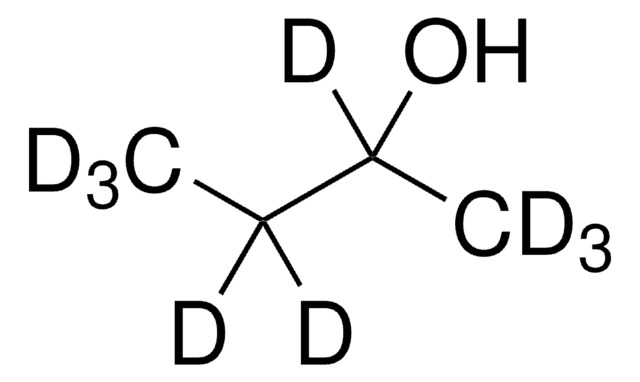B85919
2-Butanol
ReagentPlus®, ≥99%
Synonym(s):
sec-Butyl alcohol
About This Item
Recommended Products
vapor density
2.6 (vs air)
Quality Level
vapor pressure
12.5 mmHg ( 20 °C)
product line
ReagentPlus®
Assay
≥99%
form
liquid
autoignition temp.
761 °F
expl. lim.
9.8 %
IVD
for in vitro diagnostic use
refractive index
n20/D 1.397 (lit.)
bp
98 °C (lit.)
mp
−115 °C (lit.)
density
0.808 g/mL at 25 °C (lit.)
SMILES string
CCC(C)O
InChI
1S/C4H10O/c1-3-4(2)5/h4-5H,3H2,1-2H3
InChI key
BTANRVKWQNVYAZ-UHFFFAOYSA-N
Looking for similar products? Visit Product Comparison Guide
General description
Application
- As a precursor to produce 2-butanone in presence of KMnO4 oxidant and CPC (N-cetylpyridinium chloride) micellar catalyst.
- In the production of CH3NH3PbI3 perovskite films.
Legal Information
Signal Word
Warning
Hazard Statements
Precautionary Statements
Hazard Classifications
Eye Irrit. 2 - Flam. Liq. 3 - STOT SE 3
Target Organs
Central nervous system, Respiratory system
Storage Class Code
3 - Flammable liquids
WGK
WGK 1
Flash Point(F)
80.6 °F - closed cup
Flash Point(C)
27 °C - closed cup
Certificates of Analysis (COA)
Search for Certificates of Analysis (COA) by entering the products Lot/Batch Number. Lot and Batch Numbers can be found on a product’s label following the words ‘Lot’ or ‘Batch’.
Already Own This Product?
Find documentation for the products that you have recently purchased in the Document Library.
Our team of scientists has experience in all areas of research including Life Science, Material Science, Chemical Synthesis, Chromatography, Analytical and many others.
Contact Technical Service








